The ABCs of Vascular Disease

Vascular disease is a broad spectrum of conditions encompassing problems with the arteries and veins. It can affect people of all ages with varied lifestyles.
Broadly, vascular disease can be classified as arterial disease and venous disease. The symptoms for these diseases can overlap and include skin changes, leg pain, leg swelling, leg fatigue, and wounds.
To better understand the different types of vascular disease, read below to learn more. 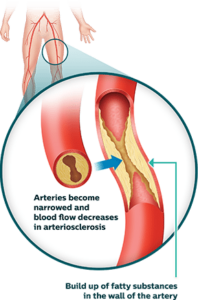
PAD- Peripheral Arterial Disease
Peripheral Arterial Disease (PAD) is the narrowing or blockage of the peripheral arteries in the body. PAD is typically caused by the buildup of atherosclerosis, or plaque, in the arteries which leads to poor blood flow and usually affects the legs or abdomen.
For more information about PAD, check out our blog post here.
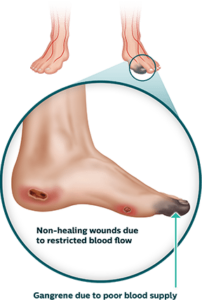 CLI – Critical Limb Ischemia
CLI – Critical Limb Ischemia
Critical limb ischemia (CLI) describes the advanced stages of PAD. If there continues to be significant plaque blockage in the arteries, blood flow can be reduced in areas like the legs and feet which can lead to leg pain at rest and nonhealing wounds.
Symptoms of CLI include severe pain while at rest, including while sleeping or while not moving, absent or weak pulse in the legs or feet, non-healing wounds below the ankle, gangrene and ultimately amputation. CLI is often associated with Diabetes, which is an independent risk factor for microvascular disease.
If you believe you may have CLI, seeking specialist help is a critical next step in order to diagnose the condition and begin treatment.
TRA Medical Imaging’s Intervascular Radiology department offers several treatment options including noninvasive vascular imaging, angiography, angioplasty, stent placement, and atherectomy. We work closely with the wound clinicians to re-establish blood flow to a wound to give it the best chance of healing.
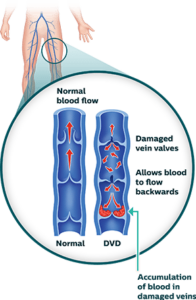
DVD – Deep Venous Disease
Deep venous disease encompasses any condition affecting the deep veins of the body. The underlying cause is venous damage, either due to prior venous thrombus (blood clot), surgery, or hereditary conditions. The underlying problem is that blood cannot be effectively returned to the heart, usually due to an obstruction. This can cause complications throughout the body such as repeated blood clots, leg or pelvic pain, varicose veins in the legs or vulva, and pooling of blood in the legs.
TRA Medical Imaging’s Vein and Vascular center offers venous ultrasound and magnetic resonance venography (MRV) for the diagnosis of deep venous disease. Therapeutic options offered at TRA include conventional venography, thrombectomy (including use of the newest techniques available), stent placement, and intravascular ultrasound.
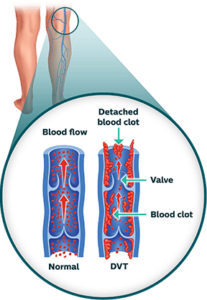 DVT – Deep Vein Thrombosis
DVT – Deep Vein Thrombosis
Deep vein thrombosis (DVT) is caused by a blood clot in a deeper vein, typically in the leg or pelvis.
There are many risk factors for developing DVT including long periods of inactivity, surgery, cancer, or trauma. Usage of hormonal birth control can also increase the risk of DVT. The biggest risk with DVT occurs when a part of the clot breaks off and travels to the lungs and creates a blockage – pulmonary embolism (PE). A large clot in the lungs can damage the lungs, or impede blood flow fatally by making the heart work too hard.
Symptoms of DVT include a cramping or diffuse pain in the calf or thigh muscles, red or discolored skin or a feeling of warmth in the affected leg.
TRA Medical Imaging’s Vein and Vascular clinic offers venous ultrasound for the diagnosis of DVT as well as many minimally invasive treatments (including new thrombectomy treatments) for the management of DVT.
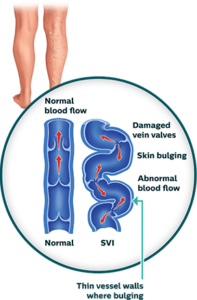
SVI – Superficial Venous Insufficiency
Superficial venous insufficiency (SVI) is a very common condition caused by damage to the venous valves in the superficial venous system. Subsequently, blood cannot be returned to the heart via these superficial veins and instead pools in the legs. This creates the secondary problem of varicose veins as well as symptoms of leg pain, swelling, aching and, enlargement.
Superficial Venous Insufficiency affects between 30-50% of the adult population, making it one of the most prevalent causes of venous disease in the U.S. Around 25 million people have varicose veins. There is a strong genetic predisposition and strong female gender predilection.
SVI is not life-threatening, though it can cause problematic skin changes and can progress over time. Symptoms of SVI include pain or swelling in the legs, skin changes, ulcers or a feeling of tired heavy legs.
TRA Medical Imaging’s Vein and Vascular clinic offers a comprehensive venous care program including non-procedural management and clinical consultation, noninvasive vascular imaging for diagnosis, venous ablation including new non-thermal technologies, ambulatory phlebectomy, visual and ultrasound guided sclerotherapy.
For more information on treatment options or to schedule a consultation, please visit our webpage.
